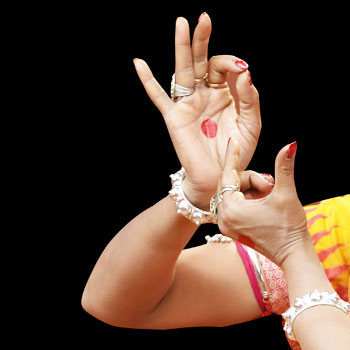
Hand Gestures
NatyaSutraOnline is an attempt to permanently preserve the rich classical dance and music heritage of India. Our dream is to provide 24/7 online access to personalized lectures, tutorials, dance classes, and performances of all Indian classical dance forms.
Bharatanatyam is India’s oldest dance form and is one of the eight officially designated ‘cultural’ dance forms in the country. Once considered a prominent temple dance, this mesmerizing spectacle has permeated into performances easily accessible anywhere in the world. These performances are a great source for the spiritual identify, beliefs and folklore of South India. Bharatanatyam performers explore topics ranging from the metaphysical to the mundane with equal poise and grace, making them integral to the soul of the land.
History of Bharatanatyam
Evidence of Bharatanatyam’s past can be traced all the way back to 200 B.C.E. Paintings and murals that have been excavated detail vivid performances of this dance form. A special case would be the gopurams of the Nataraja Temple in Chidambaram ( Tamil Nadu, the southern tip of India). The devadasis or temple maidens of the past used to perform dance offerings to the sacred deities. Modern-day Bharatanatyam can trace its origins to these performances.
Style of Bharatanatyam
The Bharatanatyam performer takes the stage alone, depicting a plethora of roles based on the story of their performance. They are accompanied by musicians and stage managers who curate the entire performance. The performances begin with invocations, and then the Alarippu, which is traditionally an offering of flowers.
An artisan must be an expert at abhinaya or acting(mime), as they depict varying characters during the retelling of the scriptures. The most integral section of the entire performance comes during the Varnam, where the true technical and storytelling prowess of the dancer is tested.
The proceedings come to an end with the thillana, a colorful sequence with roots in Hindustani music. This is followed by a performance of the mangalam, where the artist invokes the Gods to thank them for their help during the course of the performance.
Bharatanatyam Today
Bharatanatyam is deeply important to a shared South Indian cultural identity of oneness with our natural surroundings and the spiritual beings that we rever. Performers are loved for the poise, grace, and innovation that they employ to retell the stories that shaped our land. These performances headline festivals, school events and international concerts to this day.
NatyaSutra is an attempt to permanently preserve the rich art and cultural heritage of India. Our dream is to provide 24/7 online access to personalized lectures, tutorials, classes, and performances of all Indian art and culture.